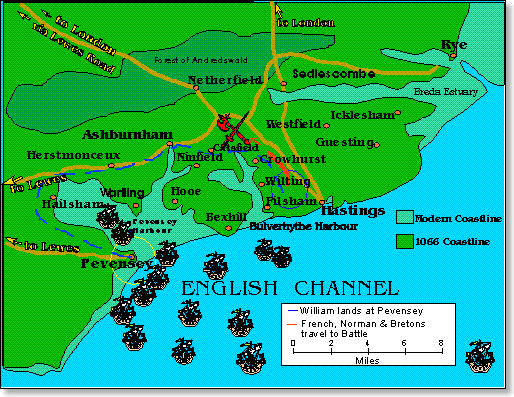G.B. - The Battle of Hastings
The Battle of Hastings
1066 and much more
A brief of the events that led to our great heritage.
Duke William of Normandy left St.Valery in Normandy with about 600 ships and 10-12,000 men on Sept 27th in 1066.
William and his barons had been recruiting and preparing the invasion of England since early spring of that year. He was a seasoned general and master tactician, using cavalry, archers and infantry and had fought many notable battles. Off Beachy Head, his ship, the Mora, arrived ahead of the fleet.. William waited and ate a hearty breakfast. As his fleet straggled into place behind him they moved eastward to the first sheltered bay to provide protection for his armada. Pevensey and Bulverhythe were the villages on each promontory. Pevensey, to the west, was protected by an old Roman Fort and behind the fort there was much flat acreage to house his large Army. To suggest this landing was not pre-planned, is not in keeping with the preparatory time taken by William, or his track record. There had been much intelligence gathering in the past few months.

The bay, wide enough for maneuverability of this large fleet, was flat shored. William is said to have fallen on the beach, grasped the sand, and declared "This is my country" or words to that effect. Next, the ships were disembarked without resistance. They included 2,500 horses, prefabricated forts, and the materiel and equipment was prepared for any contingency. The ships shuttled in and out of the bay with the precision of a D Day landing. A Fort was built inside Pevensey Roman Fort as an H.Q, while the army camped behind it. William and FitzOsborn scouted the land He was unhappy with the terrain but it had proved to be a satisfactory landing beach. Taking his army around Pevensey Bay he camped 8 miles to the east, north of what is now known as Hastings all of which was most likely pre-planned. He camped to the east outside the friendly territory of the Norman Monks of Fecamp who may have been alerted and were waiting for his probable arrival. William waited. Perhaps he was waiting to know of the outcome of the battle to the north. In those two weeks William could have marched on London and taken it. He was obviously waiting for something?
Harold, far to the north in York at Stamford Bridge, was engaged in a life and death struggle against his brother who had teamed up with the Viking King Hadrada to invade England. Whether this was a planned Norman tactic, part of a pincer movement north and south, is not known, but students of Norman and Viking history might find it very feasible. The timing of each invasion was impeccable, and probably less than coincidental. Harold managed to resist the invasion to the north and killed both commanders. He was advised of the landing to the south by William.
Bringing the remnants of his Army south, Harold camped outside London at Waltham. For two weeks he gathered reinforcements, and exchanged taunts, threats and counterclaims to the Crown of England with William. Finally he moved his army south to a position about six miles north of where William waited.
Perhaps one of the most devastating events preceeding the battle was Harold's sudden awareness that he had been excommunicated by the Pope, and that William was wearing the papal ring. It is most likely this had been arranged by fellow Norman Robert Guiscard who had conquered most of southern Italy and was patron of the Pope who was indebted to him for saving the Vatican. Harold's spirit flagged. William was leading what might perhaps by called the first Crusade. The whole world was against Harold.
William moved up to Harold's position and set up in what was then the conventional European style. Archers, infantry and cavalry in the rear. A set piece, each assigned to their own duties. .
Harold waited. He and his brother Gyrth arranged a mass of men along a high ground ridge 8 deep, 800 yards long . A fixed corridor of tightly wedged humanity. Strategically, given the relative equipment of each side, it was hopeless from the start. To William it was almost a formality. Harold's men were hemmed in by their own elbows. William, with total mobility, held his Breton, Maine and Anjou contingents to the left of the line, the Normans the main thrust, the Flemish and French to his right. The flanking movements paid off. How long the battle took has varying estimates. Some say as little as two hours. Some as long as six hours. The latter seems more reasonable simply because of the numbers involved.
This battle would later be called Senlac, a river of blood. It demolished most of the remnants of the Saxon fighting men of the Island at very little cost to William.
It is very doubtful if Harold was shot in the eye with an arrow from over the ranks of his front line. He was probably run through by William's lance, accompanied by three others who were in at the kill, and who savaged him brutally.
Thus began a three century Norman occupation of England, Wales and Scotland, and later Ireland. It all started at Pevensey.

![]()

